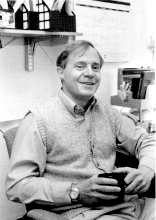 |
Research in our laboratory is focused on two major questions:
What are the progenitors of hepatocellular carcinoma and what role do
altered adhesive interactions play in the control of cell growth in normal
and malignant cells? These questions are being addressed using both rat
and human models for liver and prostate cancer. Current studies on
progenitor cells are directed towards defining stage specific cell-surface
phenotypes in developing rat and human prostate and the recapitulation of
these phenotypes in primary and transplantable carcinoma. A unique panel
of monoclonal antibodies (MAbs) developed in our laboratory is being used
to define surface phenotypes. The differentiation ability of
subpopulations isolated from fetal liver at various times in development
using FACS or magnetic bead isolation protocols are also being analyzed by
determining the capacity for differentiation into hepatocytes or bile duct
epithelial cells following transplantation into the pancreas, prostate,
liver parenchyma or biliary tree. We are also devoting a major effort
towards cloning cDNAs encoding the MAb defined surface antigens using
oligonucleotide probes or anti peptide antibodies based on primary sequence
for library screening or PCR cloning strategies. Ongoing studies on
adhesive interactions during liver or prostate carcinogenesis are centered
on the molecular pathways leading to the suppression of tumorigenicity by
CEACAM-1-4L, an Ig-like cell adhesion molecule (CAM) in the
carcinoembryonic antigen family of CAMs. Of primary interest is the role
of N-cadherin, PKCalpha, PKCzeta and TGFbeta 2, four genes shown by
immunoblot and gene array analysis to be differentially expressed by
CEACAM-1-4L suppressed PC3 human prostate carcinoma cells versus a subclone
of CEACAM-1 positive, tumorigenic revertants. In parallel, we are
investigating the mechanism by which CEACAM-1-4S, an isoform that lacks
most of the signaling motifs in the cytoplasmic tail, induces a highly
tumorigenic phenotype in rat hepatocellular carcinoma cell lines that are
poorly tumorigenic in nude mice. Finally, we are pursuing the functional
activity of a novel CEACAM-1-4L associated protein, designated p70/B31. To
this end, we have prepared monoclonal and anti peptide antibodies specific
for this protein and have a cloned cDNA that contains >90% of the coding
sequence which has no significant similarity to any known proteins.
Comegys MM, Carreiro MP, Brown JF, Mazzacua A, Flanagan
DL, Makarovsky A, Lin S-H and Hixson DC. C-CAM1 expression: Differential
effects on morphology, differentiation state and suppression of human PC-3
prostate carcinoma cells. Oncogene (1999) 18:3261-3276.
Makarovsky AN, Pu Y-S, Lo P, Earley K, Paglia M, Hixson DC and Lin S-H.
Expression and androgen regulation of C-CAM cell adhesion molecule
insoforms in rat dorsal and ventral prostate. Oncogene (1999) 18: 3252-3260.
Hixson DC, Brown J, McBride AC and Affigne S. Differentiation status of
rat ductal cells and ethionine-induced hepatic carcinomas defined with
surface-reactive monoclonal antibodies. Molecular Cellular
Pathology, in press, 2000.
Hixson DC, Chapman L, McBride A, Faris R and Yang L. Antigenic phenotypes
common to rat oval cells, primary hepatocellular carcinomas and developing
bile ducts. Carcinogenesis (1997) 18:1169-1175.
Luo W, Earley K, Tantingco V, Hixson DC, Liang TC and Lin S-H. Association
of an 80 kDa protein with C-CAM1 cytoplasmic domain correlates with C-CAM1-mediated growth inhibition. Oncogene (1998)
16:1141-1147.
|
